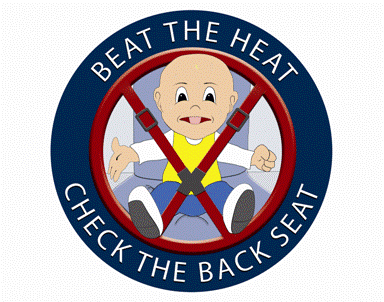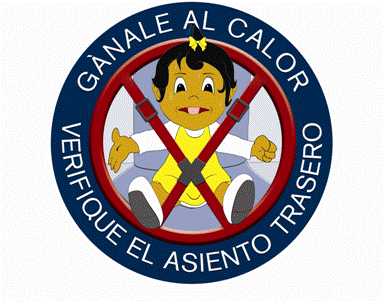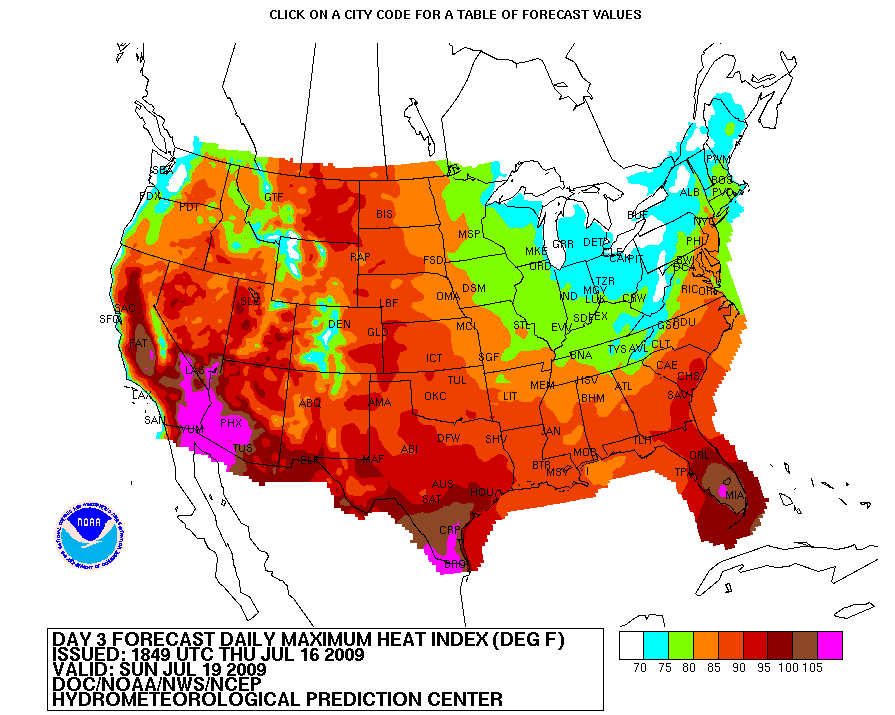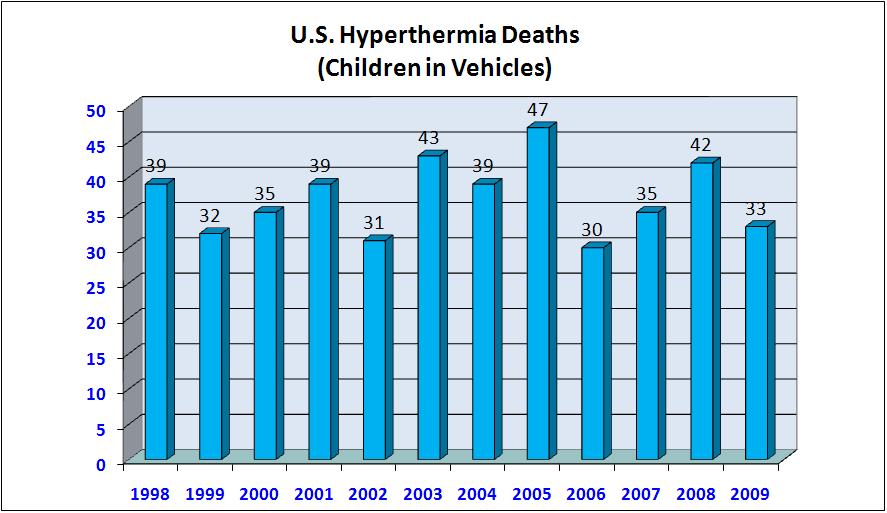|
 |
 |
Children, Adults, and Pets Enclosed in Parked Vehicles Are at Great Risk
Each year children die from hyperthermia as a result of being left enclosed in parked vehicles. Hyperthermia is an acute condition that occurs when the body absorbs more heat than it can dissipate. This can occur even on a mild day. Studies have shown that the temperature inside a parked vehicle can rise rapidly to a dangerous level for children, adults, and pets. Leaving the windows slightly open does not significantly decrease the heating rate. The effects can be more severe on children because their bodies warm at a faster rate than adults.
Hyperthermia deaths aren't confined to the summer months only. They also happen during the spring and fall. Below are some examples.
- Hawaii, March 07, 2007: A 3 year old girl from Honolulu died from hyperthermia. The child's father told police that he left her in a child seat in the back seat of the car for an hour and a half late Saturday morning while he visited friends in a Makiki apartment building. The outside temperature was only 81 degrees.
- North Augusta, SC; April 2006: A mother left her 15 month old son locked in a car. He was left in the car for 9 hours while his mom went to work. She is currently serving a 20 year prison sentence.
- Denver Aug 2008: Two kids that died in an overheated car may have been on their own for more than 3 hours as their mother slept after working a night shift. The kids died in a closed but unlocked car, investigators believe the temperature where the children were found may have reached 123 degrees.
Adults are also susceptible to hyperthermia. On July 12, 2001 a man died of heatstroke after falling asleep in his car with the windows rolled up in the parking lot of a supermarket in Hinds County, Mississippi.
VEHICLE HEATING DYNAMICS
The atmosphere and the windows of a car are relatively “transparent” to the sun’s shortwave radiation (yellow in figure below) and are warmed little. However this shortwave energy does heat objects that it strikes. For example, a dark dashboard or seat can easily reach temperatures in the range of 180 to over 200 degrees F.
These objects (e.g., dashboard, steering wheel, childseat) heat the adjacent air by conduction and convection and also give off longwave radiation (red) which is very efficient at warming the air trapped inside a vehicle.
Objects Heated by the Sun Warm Vehicle's Air
CLICK HERE FOR ANIMATION (~700K)
( Hi-Res ~ 2.5 mb.WMV file)
Individual Frames:
0 min, 10 min, 20 min, 30 min, 40 min, 50 min, 60 min
(Animation Courtesy of General Motors and Golden Gate Weather Services)
Heat Safety
Child Safety Tips
- Check to make sure seating surfaces and equipment (child safety seat and safety belt buckles) aren't too hot when securing your child in a safety restraint system in a car that has been parked in the heat.
- Never leave your child unattended in a vehicle, even with the windows down.
- Teach children not to play in, on, or around cars.
- Always lock car doors and trunks -- even at home -- and keep keys out of children's reach.
- Always make sure all child passengers have left the car when you reach your destination. Don't overlook sleeping infants.
Heat Wave Safety Tips
- Slow down - Strenuous activities should be reduced, eliminated, or rescheduled to the
coolest time of the day. Individuals at risk should stay in the coolest available place, not necessarily indoors.
- Dress for summer- Lightweight light-colored clothing reflects heat and sunlight, and helps your body maintain normal temperatures.
- Put less fuel on your inner fires - Foods (like proteins) that increase metabolic heat production also increase water loss.
- Drink plenty of water or other non-alcohol fluids - Your body needs water to keep cool. Drink plenty of fluids even if you don't feel thirsty. Persons who (1) have epilepsy or heart, kidney, or liver disease, (2) are on fluid restrictive diets or (3) have a problem with fluid retention should consult a physician before increasing their consumption of fluids. Do not drink alcoholic beverages.
- Spend more time in air-conditioned places - Air conditioning in homes and other buildings markedly reduces danger from the heat. If you cannot afford an air conditioner, spending some time each day (during hot weather) in an air conditioned environment affords some protection.
- Don't get too much sun - Sunburn makes the job of heat dissipation that much more difficult
- Do not take salt tablets unless specified by a physician
Know These Heat Disorder Symptoms
SUNBURN: Redness and pain. In severe cases swelling of skin, blisters, fever, headaches. First Aid: Ointments for mild cases if blisters appear and do not break. If  breaking occurs, apply dry sterile dressing. Serious, extensive cases should be seen by physician.
breaking occurs, apply dry sterile dressing. Serious, extensive cases should be seen by physician.
HEAT CRAMPS: Painful spasms usually in muscles of legs and abdomen possible. Heavy sweating. First Aid: Firm pressure on cramping muscles, or gentle massage to relieve spasm. Give sips of water. If nausea occurs, discontinue use.
HEAT EXHAUSTION: Heavy sweating, weakness, skin cold, pale and clammy. Pulse thready. Normal temperature possible. Fainting and vomiting. First Aid: Get victim out of sun. Lay down and loosen clothing. Apply cool, wet cloths. Fan or move victim to air conditioned room. Sips of water. If nausea occurs, discontinue use. If vomiting continues, seek immediate medical attention.
HEAT STROKE (sunstroke): High body temperature (106° F or higher). Hot dry skin. Rapid and strong pulse. Possible unconsciousness. First Aid: HEAT STROKE IS A SEVERE MEDICAL EMERGENCY. SUMMON EMERGENCY MEDICAL ASSISTANCE OR GET THE VICTIM TO A HOSPITAL IMMEDIATELY. DELAY CAN BE FATAL. Move the victim to a cooler environment Reduce body temperature with cold bath or sponging. Use extreme caution. Remove clothing, use fans and air conditioners. If temperature rises again, repeat process. Do not give fluids. Persons on salt restrictive diets should consult a physician before increasing their salt intake.
*For more information contact your local American Red Cross Chapter. Ask to enroll in a first aid course.
Community Guidance: Preparing for and Responding to Excessive Heat Events
The "Excessive Heat Events Guidebook" was developed by the Environmental Protection Agency (EPA) in 2006, in collaboration with NOAA's National Weather Service (NWS), the Centers for Disease Control and Prevention (CDC), and the U.S. Department of Homeland Security (DHS). This guidebook provides best practices that have been employed to save lives during heat waves in different urban areas, and provides a menu of options that communities can use in developing their own mitigation plans.
Produced as a cooperative effort of NOAA's National Weather Service, the Federal Emergency Management Agency, and the American Red Cross.
- Web Site Owner:
- National Weather Service
- Louisville, KY Weather Forecast Office
- 6201 Theiler Lane
- Louisville, KY 40229-1476
- 502-969-8842
- Page Author: LMK Webmaster
- Web Master's E-mail: w-lmk.webmaster@noaa.gov
- Page last modified: June 1st 2011 2:42 PM




